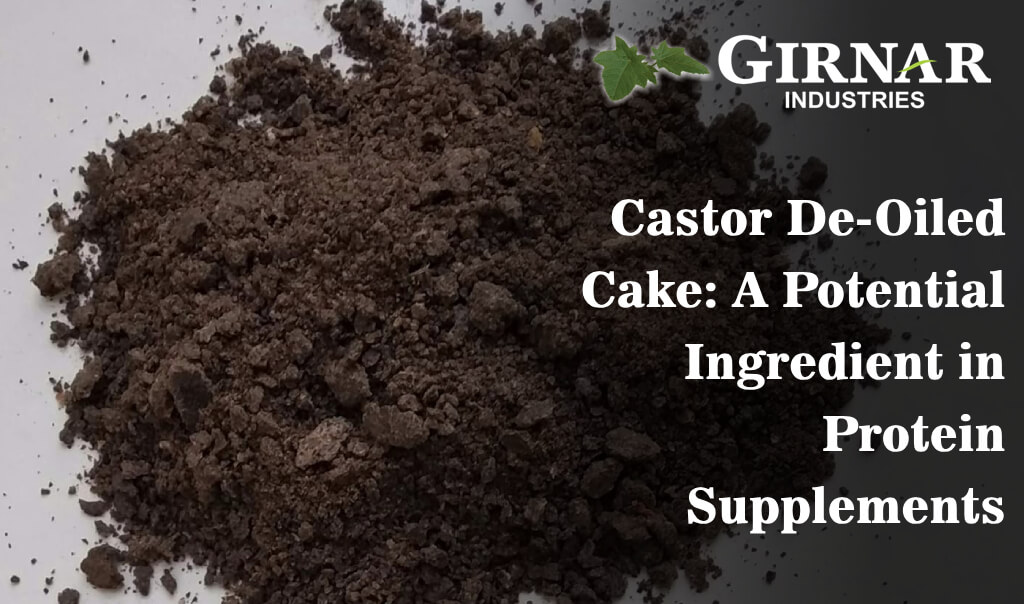An invisible rival emerges from the shadows in nutrition: castor de-oiled cake. While it might not be a household word, this byproduct of castor oil extraction shows promise as a potential inclusion in protein supplements. Let’s look at castor de-oiled cake’s nutritional profile and its possibilities.
Introducing the Castor De-Oiled Cake
Castor de-oiled cake is a byproduct of the castor oil extraction process. Castor oil, which has numerous commercial and therapeutic uses, is derived from the seeds of the castor plant (Ricinus communis). After the oil is drained, the de-oiled cake remains, which is generally neglected but high in nutrients.
The Nutritional Powerhouse
The cake that only looks like a little is more than just a waste product. A lot of protein is in it, which could make it a contender in the protein supplement market. Essential amino acids are the building blocks of proteins our bodies can’t make independently. They are found in castor de-oiled cake and help the protein content.
Beyond protein, the cake has many elements, such as fiber, vitamins, and minerals. While it may not grab the attention of fashionable superfoods, its nutritional profile demonstrates its promise as a nutritious foodstuff.
Protein Punch without the Fluff
The pure protein content of castor de-oiled cake is one of the best things about using it in protein supplements. Some protein sources add extra sugar, artificial tastes, or preservatives. On the other hand, It gives you protein without all the extra stuff.
This simplicity is more than just a question of minimalism; it pays homage to individuals who value clean, unadulterated nutrients. Castor de-oiled cake might be the solution for people seeking a no-nonsense approach to protein supplementation.
Sustainability on the Horizon
As the world grapples with sustainability challenges, including castor de-oiled cake in protein supplements is an intriguing possibility. Castor plants are tough and tenacious, requiring little water and resisting pests. This durability translates into a possible long-term protein supply.
Furthermore, by using a byproduct such as a castor de-oiled cake, we help to create a more circular economy by decreasing waste and maximizing the utility of the entire castor plant. In this setting, sustainability is more than a buzzword; it is a practical benefit corresponding to the expanding environmental consciousness.
For More Blogs:- benefits of groundnut oil, Food grade castor oil
Addressing Concerns: Safety and Allergens
Safety issues must be addressed before it becomes a common ingredient in protein supplements. Castor seeds have a poisonous stuff called ricin that must be carefully removed before the oil can be extracted. The de-oiling method must eliminate any ricin so the cake is safe to eat.
Furthermore, while it tends to be harmless, allergy sufferers should exercise caution. As with any new ingredient, it’s best to introduce it gradually and check for side effects.
Culinary Exploration: How to Incorporate Castor De-Oiled Cake
When introducing a new ingredient into the supplement market, culinary considerations are critical. The slightly nutty taste of castor de-oiled cake makes it useful in many recipes. From protein bars and shakes to baked items, the cake may be easily incorporated into daily dietary routines.
Experimenting in the kitchen can lead to tasty, healthy snacks that people of all tastes can enjoy. It can reach its full potential without the need for complex mixtures if simple, healthy recipes are used.
The Road Ahead: Research and Development
While the early results are encouraging, more research and development are required to fully understand the benefits and limitations of integrating castor de-oiled cake into protein supplements. Scientific research can inform about its bioavailability, digestibility, and overall effect on human health.
Collaboration between scientists and the food industry is essential for realizing the full potential of castor de-oiled cake. This cooperation has the potential to spur innovation while guaranteeing that any goods developed from this humble byproduct fulfill the highest safety and efficacy criteria.
Conclusion
It is a fascinating challenge in protein supplements, providing a simple and potentially sustainable protein supply. While it lacks the glitter of popular superfoods, its nutritional profile, simplicity, and culinary adaptability make it a contender worth considering.
FAQ’S
What is the use of castor de oiled cake?
Castor de-oiled cake serves as a valuable ingredient in protein supplements due to its high protein content. Derived from the castor bean after oil extraction, this versatile byproduct contains essential amino acids, making it an excellent plant-based protein source. It contributes to muscle building, tissue repair, and overall health.
How castor cake is made?
Castor de-oiled cake is produced through a multi-step process. Initially, castor seeds undergo mechanical pressing to extract oil, leaving behind the de-oiled cake. The residual cake undergoes a solvent extraction phase, further reducing oil content. After extraction, the cake is toasted or heat-treated to remove any remaining traces of solvent.
What are the nutrients in castor cake?
Castor de-oiled cake is a nutrient-dense ingredient, boasting a rich profile essential for various applications. It contains approximately 35-40% protein, providing crucial amino acids vital for muscle development and repair. Additionally, it offers carbohydrates, fiber, and essential minerals like phosphorus and potassium.
What is the NPK content of castor cake?
The NPK (Nitrogen, Phosphorus, Potassium) content of castor cake makes it an excellent organic fertilizer. Typically, it contains about 4-5% nitrogen, 2-2.5% phosphorus, and 1-1.5% potassium. This balanced nutrient profile enhances soil fertility, promoting robust plant growth and increased yield. The slow-release nature of these nutrients from castor cake ensures sustained nourishment for plants.
What is the shelf life of oil cake?
The shelf life of castor de-oiled cake is influenced by storage conditions. When stored in a cool, dry place away from direct sunlight and moisture, it can maintain quality for up to six months. However, proper packaging and airtight containers are crucial to prevent oxidation and maintain freshness. Additionally, periodic checks for any signs of rancidity or spoilage are recommended.


